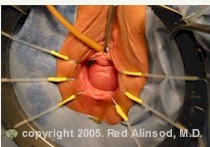Incontinence Sling
The urethra is the tube that drains the bladder. The urethra is where you see urine coming out. This structure may fall down just like the bladder does. This often results in leakage of urine when one coughs, laughs, jumps, or bends down. Repair of this organ often means you must place a mesh below it and support it to stop the leakage of urine. Many women have urethroceles with absolutely no symptoms. No surgery is needed in these asymptomatic patients. However, when symptoms occur, new minimally invasive technologies have been developed.
The newest and safest trend to deal with incontinence involves the use of polypropylene, an inert nylon-type material, that is placed right under the mid urethra to act as a backboard when one sneezes or coughs to then occlude or block the urethral opening and either decrease of stop the leakage of urine. These procedures are all called “Tension-Free” because the slings are not sutured into muscle, fascia, or bone and are just left alone for ones own fibroblast to ingrow and hold the mesh. You may hear the term TVT or TOT. They refer to the route the slings are placed. TVT, or tension-free vaginal tape can be placed through an incision right above your pubic bone. TOT, or transobturator tape, is placed through incisions on the crease of your inner thighs. These incisions are just about invisible. Both procedures are outpatient surgeries of about 15 to 30 minutes. Newer sling technologies have even eliminated the skin incisions and are placed totally vaginal using “short tape” technology. The success rates vary from 80 to 95 percent. Incontinence slings are done under general, regional, or local anesthesia in the surgery center or operating room. Most insurance companies cover this procedure.
 Cystocele or Fallen Bladder |
 |